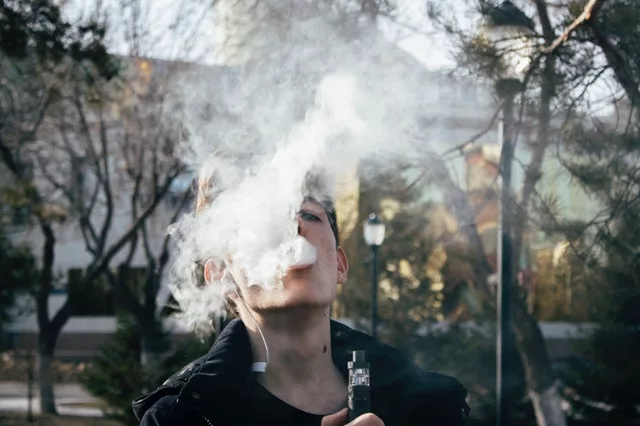Home » The FDA Campaigns Against Flavored Tobacco Products
The FDA Campaigns Against Flavored Tobacco Products

February 27, 2019
From The Carlat Addiction Treatment Report
Thomas Jordan, MD
Talia Puzantian, Pharm.D.
Drs. Jordan and Puzantian have disclosed that they have no relevant financial or other interests in any commercial companies pertaining to this educational activity.
Electronic cigarette use, or vaping, is becoming increasingly common. Companies manufacturing e-cigarettes advertise them as alternatives to conventional cigarettes and even a pathway to smoking cessation. However, the popularity of vaping has sky-rocketed in high schools across the country with adolescents becoming addicted to nicotine daily. Monitoring the Future Survey (MTF) (http://monitoringthefuture.org; Miech et al, N Engl J Med 2018;379:623-632) results have just been released, and they are quite concerning.
Nearly 14,000 8th, 10th, and 12th graders were surveyed about their use of various substances over the past thirty days. The annual survey extends back to 1975 for 12th graders; the younger ages were added more recently. Over the history of MTF, the single greatest absolute increase in any substance happened this past year—12th graders reporting use of vaped nicotine nearly doubled from around 11% in 2017 to 21% in 2018 (of note, it was only 1.5% in 2011). Overall, there are an additional 1.3 million high school students that vaped in 2018 compared to 2017. Reasons adolescents have given for starting to vape include the sleek, futuristic style of the devices themselves—some look like USB flash drives. Interestingly, when teens were asked what is in their e-cig, 66% said just flavoring, 14% didn’t know, 13% said nicotine and the rest said marijuana or other (manufacturers are not required to report e-cig ingredients so users can’t easily know what’s actually in them). Most e-cigs contain 5% nicotine, roughly the equivalent of a pack of cigarettes with flavors appealing to young people such as crème, cotton candy, gummy bear and bubble gum.
The FDA was initially caught off-guard by the surge in e-cigarette use among high school students. In fall of 2018 the FDA proposed a ban on flavors in e-cigarettes to help curb adolescent vaping. However, the FDA fell short of enacting an all-out flavor ban. Instead, it has proposed requiring flavored vaping products sold in retail stores to be kept in a closed-off area. Vape companies like Juul (who controls over 70% of the e-cigarette market share) are also volunteering their own restrictions. Juul announced in November 2018 that it would curtail its social media presence and stop selling flavored e-cigarettes (except tobacco, mint, and menthol flavors) in retail stores, but they are still available from its website.
While adults may use e-cigarettes as a possibly safer alternative to smoking or a stepping stone to smoking cessation, vaping is proving to be a mixed blessing at best. Some authorities argue that vaping represents a harm reduction approach, relative to the high risk of cancer, lung, and cardiovascular disease associated with tobacco cigarettes. Others point out that the nicotine in vape is just as addictive as that found in regular cigarettes, and that vaping has led to a new generation becoming addicted to nicotine.
Addiction TreatmentNearly 14,000 8th, 10th, and 12th graders were surveyed about their use of various substances over the past thirty days. The annual survey extends back to 1975 for 12th graders; the younger ages were added more recently. Over the history of MTF, the single greatest absolute increase in any substance happened this past year—12th graders reporting use of vaped nicotine nearly doubled from around 11% in 2017 to 21% in 2018 (of note, it was only 1.5% in 2011). Overall, there are an additional 1.3 million high school students that vaped in 2018 compared to 2017. Reasons adolescents have given for starting to vape include the sleek, futuristic style of the devices themselves—some look like USB flash drives. Interestingly, when teens were asked what is in their e-cig, 66% said just flavoring, 14% didn’t know, 13% said nicotine and the rest said marijuana or other (manufacturers are not required to report e-cig ingredients so users can’t easily know what’s actually in them). Most e-cigs contain 5% nicotine, roughly the equivalent of a pack of cigarettes with flavors appealing to young people such as crème, cotton candy, gummy bear and bubble gum.
The FDA was initially caught off-guard by the surge in e-cigarette use among high school students. In fall of 2018 the FDA proposed a ban on flavors in e-cigarettes to help curb adolescent vaping. However, the FDA fell short of enacting an all-out flavor ban. Instead, it has proposed requiring flavored vaping products sold in retail stores to be kept in a closed-off area. Vape companies like Juul (who controls over 70% of the e-cigarette market share) are also volunteering their own restrictions. Juul announced in November 2018 that it would curtail its social media presence and stop selling flavored e-cigarettes (except tobacco, mint, and menthol flavors) in retail stores, but they are still available from its website.
While adults may use e-cigarettes as a possibly safer alternative to smoking or a stepping stone to smoking cessation, vaping is proving to be a mixed blessing at best. Some authorities argue that vaping represents a harm reduction approach, relative to the high risk of cancer, lung, and cardiovascular disease associated with tobacco cigarettes. Others point out that the nicotine in vape is just as addictive as that found in regular cigarettes, and that vaping has led to a new generation becoming addicted to nicotine.
Issue Date: February 27, 2019
Table Of Contents
Recommended
Newsletters
Please see our Terms and Conditions, Privacy Policy, Subscription Agreement, Use of Cookies, and Hardware/Software Requirements to view our website.
© 2025 Carlat Publishing, LLC and Affiliates, All Rights Reserved.


_-The-Breakthrough-Antipsychotic-That-Could-Change-Everything.webp?t=1729528747)



